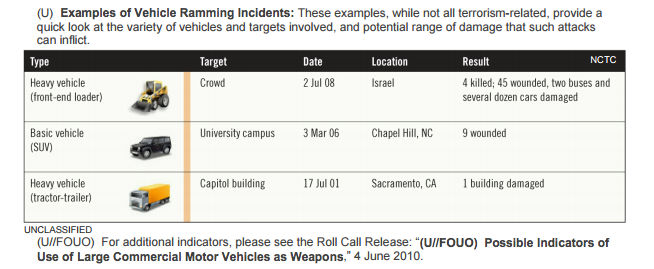The FBI Gave a Grim Warning About the Attack in Nice, France 6 Years Ago

By:
A truck barreled down a main road in Nice, France on Thursday slamming into French families and tourists.
The deliberate attack by Mohamed Lahouaiej Bouhel, 31, killed at least 84 people and injured at least 200 people on the Promenade des Anglais on Bastille Day, a celebration of French national pride.
The method of using a vehicle for an attack might be shocking to some Americans, but not to the FBI or the Department of Homeland Security.
In 2010, the agencies released a joint warning about vehicle attacks.
 Department of Homeland Security - publicintelligence.net
Department of Homeland Security - publicintelligence.net
Vehicle attacks have happened in the U.S. before.
In July of 2001, Mike Bowers, 37, rammed a commercial truck into the state Capitol building in Sacramento, California at 70 mph because he was angry with former Gov. Gray Davis, who was the governor at the time. The truck exploded and killed Bowers, damaging the building. No one else was hurt, according to SFGate.
In March of 2006, Mohammed Taheri-azar intentionally drove his Jeep into people on the Chapel Hill campus of the University of North Carolina.
He said that he wanted to kill people because of the U.S. government's treatment of Muslims abroad. Taheri-azar hit nine people but none of them were seriously injured or killed, according to local North Carolina station WRAL.
Outside of the U.S., but close to home, there was a ramming attack in 2014 in Canada.
Martin Ahmad Rouleau slammed his car into two Canadian soldiers, killing one, according to the National Post. He had been previously investigated by authorities for his radical religious beliefs.
ATTN: talked to terror expert and senior fellow at the Foundation for Defense of Democracies Daveed Gartenstein-Ross, Ph.D.
Gartenstein-Ross said that there is a perfectly logical reason that Americans don't think about ramming attacks in the U.S.: Guns are still more deadly.
"The kind of attacks that we have in the United States where people get killed, they're primarily shooting attacks," he said. "It's based off of the likelihood that if a mass tragedy hits your community, where a number of people are killed by someone intentionally targeting them, just by sheer percentages it's likely to be shooting."
He also said it would be unlikely for a vehicle attack like the one in France to be as deadly in the U.S.
"Given the relative competence and lethality of U.S. law enforcement, that had an attack like this been attempted, let's say at New Year's Eve festivities or the like, that it just wouldn't have been as lethal because law enforcement would have blown out the tires pretty quickly," he said. Bouhel drove for more than a mile (two kilometers) before he was shot and killed by police, according to CNN.
Gartenstein-Ross said that although the attack in Nice was devastating, vehicle attacks are still not the top terrorism killers around the world.
"Other than Israel you don't have this as a common tactic," he said. Israel has strict check points and gun laws that make cars and trucks easier tools than guns.
"If you were to tell 20 terrorist experts, without them knowing anything about the Nice attack, that there is going to be an attack in France and 80 people would get killed, and ask 'how do you think they were killed?' Probably a ramming attack would not appear on the top four list of the vast majority of the experts," he said.
Bombing and shooting attacks would have been higher on the list.
However, the Islamic State has pushed for more vehicle attacks, and Gartenstein-Ross said that because the Nice attack was able to kill so many people, copy attacks could follow.
"Successful attacks, other groups tend to try to replicate them," he said. "When you have a deadly success like this, it certainly is something that should be a part of what we're thinking about."
